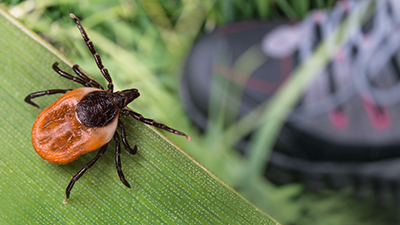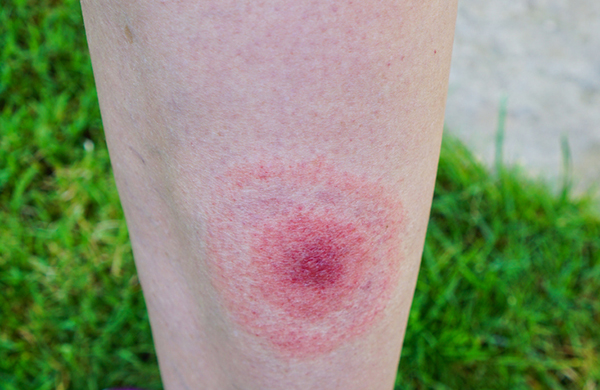These Tiny Insects Can Spread Lyme Disease
This summer thousands of Michigan residents are flocking to campgrounds, golf courses, hiking and walking trails either in or surrounded by woods. Whether their adventure is in the western Upper Peninsula, along the Lake Michigan coast, or further inland in the southern part of the state, they will be sharing the great outdoors with ticks. Lots of them.
There has been a significant increase in the state’s tick population this year. This explosion has led many Michiganders to brush up on the precautionary measures to reduce the chances of being bitten by ticks.

Protect yourself by covering up as much skin as possible when going to grassy or wooded areas. Wearing a hat, long-sleeved shirt, and long pants with the legs tucked into socks can be helpful. You can also use a bug repellant that contains a chemical such as DEET, IR3535, or Picaridin. Always check clothing after being outside, remove any ticks, and toss the clothes in a dryer and run it on the high-heat cycle for an hour to kill any ticks that remain. You should also take a shower within two hours of coming inside.
“Most tick bites will resolve themselves and not lead to Lyme disease,” said, Jennifer Edwards-Johnson, DO, of McLaren Flint’s Family Medicine Residency Group Practice. “But it is best to avoid getting bitten in the first place.”
TICKS
If a tick is latched on to your skin, Dr. Edwards-Johnson says it is important to remove it as quickly as possible. But if the tick is already engorged, it would be best to have a healthcare professional remove it. The best way to remove a tick is to use a pair of tweezers to grip it by its head and mouth so they do not remain embedded in your skin when the tick is pulled away from where it is attached.
“The bacteria that causes Lyme disease is transmitted through the tick’s saliva,” Dr Edwards-Johnson. “That is why you want to do your best to remove the mouth from the skin.”
Leaving a tick’s head and mouth in the skin does not increase the risk of a tick-borne disease. However, it can raise the risk of infection and should not be left in the body. If a tick is attached to an open patch of skin, it is easy to determine if its head and mouth came off when it was removed. That can be more difficult to do if a tick was embedded in an area of your body where there is a lot of hair.

If a tick is not attached to your skin, a red bump resembling a mosquito bite or a bull’s-eye rash can be a sign of a tick bite, particularly if the bump does not itch and fades away after a couple of days.
Female blacklegged ticks, which are also known as deer ticks, are responsible for the spread of Lyme disease. Adult male deer ticks will latch on to humans to feed but they do not remain attached long enough to transmit the disease. A female blacklegged tick typically needs to be attached to someone for 36 hours or longer for Lyme disease to develop. However, it can be difficult to determine how long a tick has been latched on to someone because the time needed for it to become visibly engorged can vary from two to 30 hours.
“Unfortunately, because there is an anesthetic in the saliva of the ticks, most people don’t know they have been bitten,” added Dr. Edwards-Johnson. “They could be bitten in areas where they would not normally check, such as behind the ears or under the waistband of their clothing.”
TREATMENT
Antibiotic treatments are available to patients who appear to have had a blacklegged tick attached to them for 36 hours or longer and who have recently traveled to an area where Lyme disease is prevalent and/or are experiencing symptoms, such as a rash, fever, or chills.
If left untreated, Lyme disease can cause a lot of issues. A person can develop severe symptoms, such as swelling and joint pain, much like that associated with arthritis, as well as tingling and numbness in their hands, feet, and back. Some can also experience a lack of energy, difficulty focusing, poor memory, and even weakness or paralysis in their face.
“Treatment should be a prolonged observation,” Dr. Edwards-Johnson said. “We will often prescribe antibiotics, but that does not absolve you of having to be re-checked by your primary care physician. There are such late-appearing effects with Lyme disease that we definitely want people to follow up with their primary care physician.”